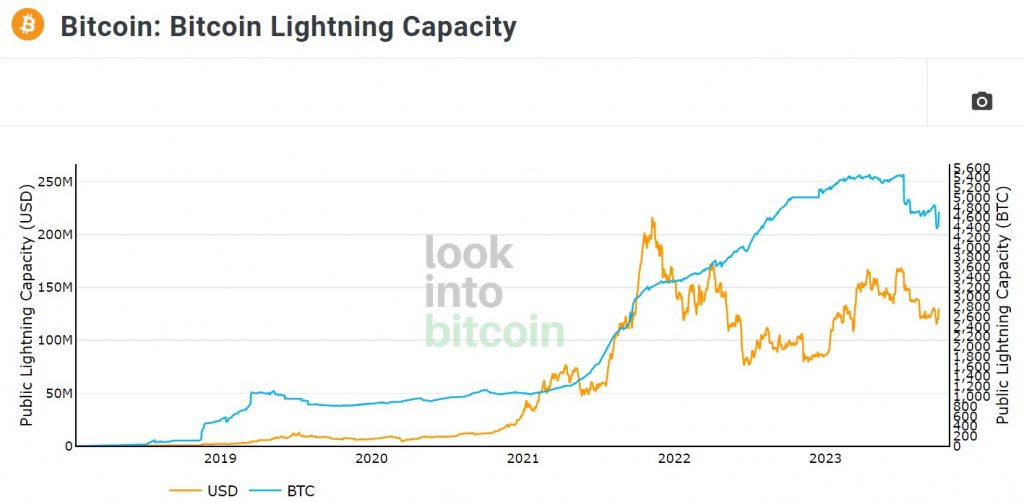The Bitcoin Lightning Network, a Layer-2 solution designed to enhance scalability, has recently witnessed a substantial decline in its cumulative Bitcoin (BTC) capacity. This drop might raise concerns for some Bitcoin enthusiasts, but a closer look reveals that it’s not necessarily a negative development. In fact, it could be viewed as a positive indicator for investors of the digital asset.
Understanding the Lightning Network
The Lightning Network, introduced as a solution to Bitcoin’s scalability challenges, saw its peak in March 2022 with over 20,000 nodes. However, since then, the number of nodes has declined.

Yet, intriguingly, the BTC capacity on the Lightning Network reached an all-time high of 5,498 BTC in July this year. These figures help gauge the network’s demand and efficiency.
Capacity vs. Nodes
A Lightning node serves as the network’s transaction verifier. It expedites Bitcoin transfers and reduces transaction costs. On the other hand, capacity reflects the liquidity within the network, signifying the volume of total payments. FXStreet believes that the recent decrease in capacity, although notable, should not be a cause for concern.
A Bullish Perspective
Over the past few months, BTC capacity on the Lightning Network has seen a consistent 13.7% decline, from 5,468 BTC to 4,716 BTC. This decline, according to Sam Wouters, a Research Analyst at River Lightning, is a positive development.
Node operators have begun to realize that they can achieve the same or even more with reduced capacity. This reduction is a strategic move aimed at better aligning capital and efficiently managing channels.
Steady Node Numbers
While the decrease in capacity isn’t alarming, the stability in the number of nodes on the network since the start of the year is significant. Despite fluctuations, the number has remained around 17,000. This consistent figure suggests that the Lightning Network continues to attract and retain participants.
The decline in node numbers has not had a substantial impact on Bitcoin investors, assuring them of a stable environment with limited volatility. However, when examined from a broader perspective, a stagnant number of nodes could be interpreted as a bearish sign for the network’s adoption.
Final Thoughts
Overall, the Bitcoin Lightning Network’s falling capacity should not be a source of concern for BTC investors. Instead, it can be seen as a positive development, indicating a more efficient allocation of resources within the network. The network’s stability in terms of node numbers also suggests resilience.
While the impact on investors has been minimal, it’s essential to keep an eye on the network’s growth to ensure the long-term success of Lightning Network as a scaling solution for Bitcoin.
Giancarlo is an economist by profession with a career spanning nearly two decades. His professional journey has seen him assume vital roles in various government and private organizations such as the Department of the Interior and Local Government (DILG), the National Economic and Development Authority (NEDA), Megaworld Corporation, and the China Banking Corporation in the Republic of the Philippines.
In addition to his civic and corporate pursuits, his forward-thinking approach has led him to manage several prominent websites in the banking and finance sector, notably the Australia-based RateChoice, where he immersed himself in the world of emerging financial technologies and where he found particular interest in Bitcoin all the way back to 2013.
Prior to his addition to Blockzeit’s dynamic team, he held an essential role as Project Manager for initiatives encompassing blockchain, stablecoin, mining, special economic zone development, and iGaming. This noteworthy chapter in his career unfolded under the auspices of InPlan Consultancy Services, Inc., the think-tank of IMPERO Consortium Management Corporation headquartered in Manila, Philippines, and Tokyo, Japan. InPlan, led by a distinguished retired Cabinet member of the Philippines, collaborates directly with IMPERO’s core management team, contributing to strategic planning and business development endeavors.












